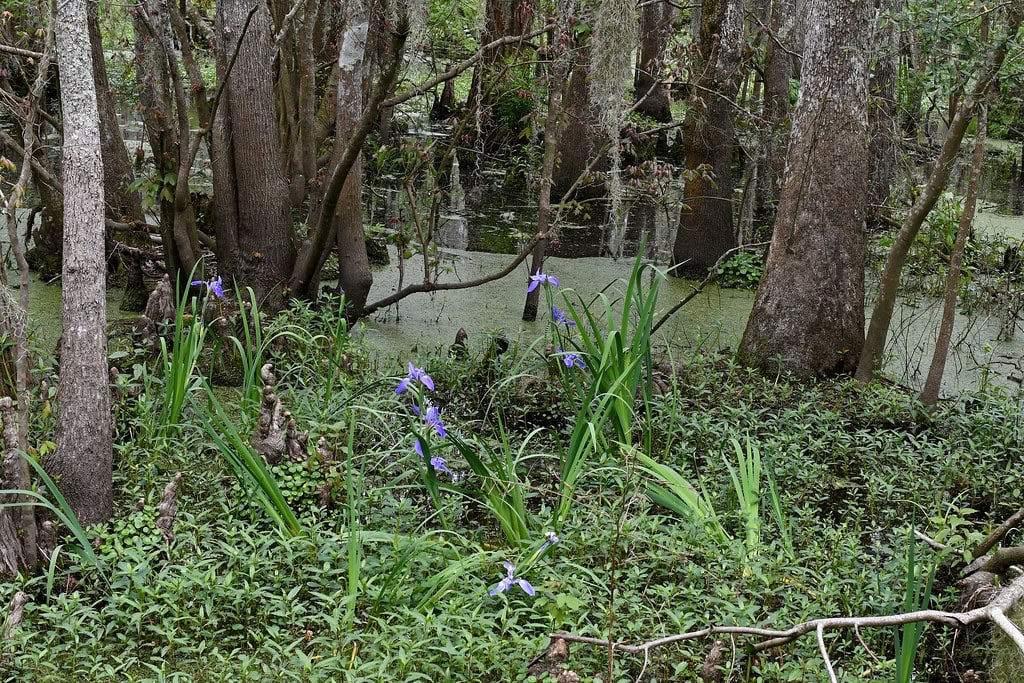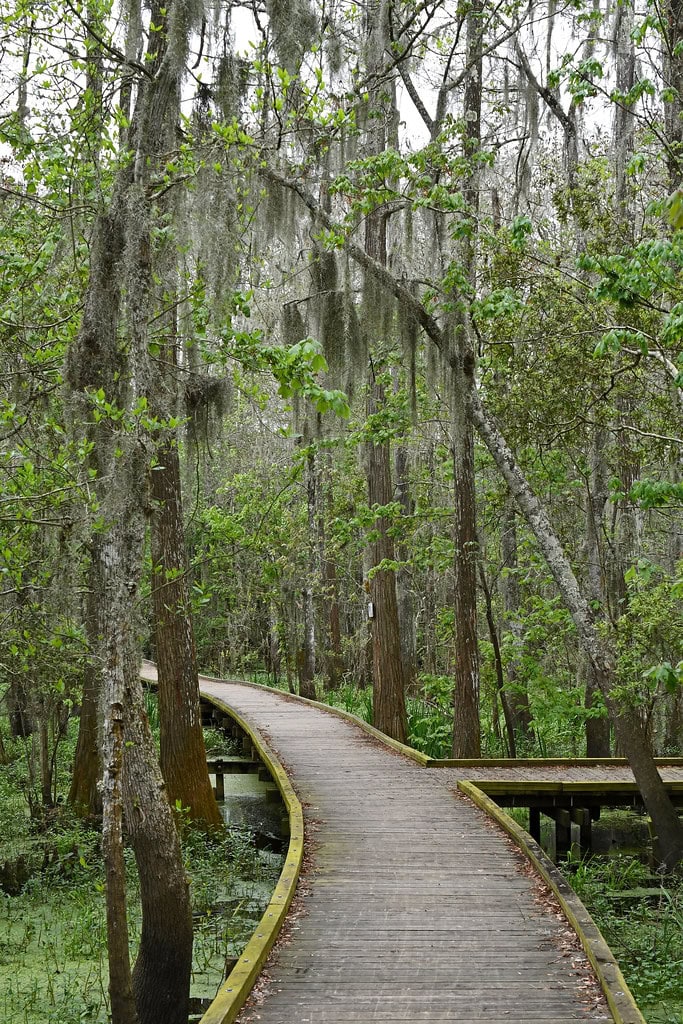Swamp Roads and Cypress Deals
Joyce Wildlife Management Area (Joyce WMA) doesn't announce itself with neon signs or visitor centers packed with brochures.
Most people heading down I-55 or old Highway 51 probably don't realize they're skimming past 42,000 acres of protected marshland rimmed by old river channels and swamps that once faced clear-cutting.
It's 10 miles south of Hammond and just past Ponchatoula, which makes it an easy place to miss if you're not looking for it.
But the story behind it, how that land got saved, who handed it over, and what it's become, makes a stronger case for memory than most roadside attractions ever could.
No state monument stands for the families who signed off on the deeds or the funders who pieced together the purchase deals.
Still, their influence is baked into every acre. This stretch of Louisiana swamp holds traces of each hand that kept it from being lost.
If you're after things to do in Hammond, Louisiana, that story alone is worth the stop.
The Acreage That Built a Refuge
The Joyce Wildlife Management Area began with a 12,809-acre land transfer in 1982 from the Joyce Foundation to the Louisiana Department of Wildlife and Fisheries.
That was the initial handoff. Not flashy. No ceremony. Just paperwork and swamp.
Then came more. In 1994, the Guste Heirs contributed 2,250 acres. Fourteen years later, in 2008, another major piece joined the map.
The Conservation Fund helped acquire over 7,200 acres known as the Octavia Tract, which had been leased previously.
The tract contained 100 acres of ancient cypress near Ponchatoula that had avoided harvest thanks to then-mayor John Jacob Dahmer, who held office from 1952 to 1960.
He stepped in when lumber companies had already cleared most of the surrounding stands. That deal wasn't cheap.
It took a $1.67 million NOAA grant, a $392,000 boost from the North American Wetland Conservation Act, and a slice of private funding organized through The Conservation Fund.
Shell Oil contributed $250,000, and Ameriprise Financial added $200,000.
Combined, those inputs dropped the state's cost substantially.
Later, 2,729 acres called the Dendinger Tract were added in 2010.
By then, the idea of a sprawling public swamp refuge wasn't just theory.
It was mapped, protected, and partially restored.
Wildlife Inventory, No Velvet Ropes
Joyce WMA is full of edges that don't show up on the map.
The protected line wraps around 42,292 acres, but what lives inside changes constantly.
Migratory ducks drop in, pull out, shift around. Some stay through the winter. Others don't.
Waterfowl here include wood ducks, mottled ducks, hooded mergansers, and black-bellied whistling ducks.
All are year-round residents. They nest, they feed, they vanish behind cattails.
White-tailed deer are seen in hunting reports every season.
There are fish in the deeper canals and bayous.
Largemouth bass, chinquapin perch, and catfish move in the dark water, especially near the stretches of submerged timber.
Freshwater marsh covers about 500 acres here, which helps sustain that diversity.
Reptiles and amphibians aren't tracked as tightly, but alligators and tree frogs are part of the picture.
Bald eagle nests have been verified in and near the Joyce WMA.
Same for osprey. These records come from field surveys and eBird logs kept by state staff and volunteer monitors.
No velvet ropes or spotting scopes are required, just a patient pair of eyes and the time to look.

Hunting, Cast Nets, and Rubber Boots
You won't see visitor kiosks at Joyce WMA. Access doesn't come through paved loops or staffed gates.
Most people get in by boat - pirogues or small craft launched at North Pass, Lee's Landing, or Traino Landing.
That choice limits traffic naturally. The swamp keeps its own pace.
Rules follow the terrain. The northwest corner holds a Limited Access Area where internal combustion engines are banned year-round.
Deer season varies by method. Archery, primitive firearms, and modern firearms all have their assigned weeks.
In 2025, the primitive season was extended to February 1-2 after winter weather delays.
Raccoon night hunting was pushed through March 2 under the same emergency order.
Rabbit hunters logged 24 takes in 2023-24, with an effort rate of just under 0.9 per hunter.
That bump was due partly to the lack of high-water events, which often push small game out of reach.
Squirrel season tracks close behind, drawing steady attention when the tree canopy's full.
Fishing doesn't follow the calendar as tightly. People drop lines for bass and perch year-round.
There are no bait shops nearby. Bring what you need, or you're done before you start.
Joyce isn't remote by distance, but by design, it stays hard to predict.
Walkway Through the Cypress, No Sales Pitch Needed
The Swamp Walk isn't long. It doesn't snake deep into the hardwoods or loop through multiple zones.
But since 1990, it's been a rare way to step out above water without a boat.
Built at the northwest edge of Joyce WMA, it stretches across a standing swamp where root systems tangle below black water.
The walkway was badly damaged in 2012 by Hurricane Isaac.
It stayed closed until January 21, 2015, when reconstruction was finished using treated lumber and elevated supports.
Flooding in 2016 forced another shutdown, though shorter.
Each repair brought questions about how much longer to keep fixing it and whether people would even use it.
But the boardwalk stayed. Local reports tracked iris blooms each spring and posted wildlife photos from its rails.
As of 2024, the Swamp Walk is open for daylight access only.
No firearms within 100 yards. No dogs. No bikes. The rule signs are simple. It's a place that shows more than it tells.
The trailhead sits off Old Highway 51. If you blink, you'll pass it. But the structure holds. The footing's firm, even if the water below never is.

Wetland Outreach and Who Shows Up
Joyce WMA doesn't run public workshops every weekend.
There aren't kiosks handing out pins, and there's no gift shop selling cypress souvenirs.
But education does happen, and most of it takes place right out in the field.
That might be a scheduled school tour led by LDWF staff or a quiet survey project tagged by local biologists.
Either way, the knowledge is built from the ground level.
In recent years, local partnerships have shaped how Joyce connects with visitors.
School groups from Tangipahoa Parish use the Swamp Walk to study native plants, hydrology, and wildlife cycles.
Birders log species into eBird using checklists specific to the area.
The WMA sits on the American Wetlands Birding Trail, which attracts attention during migration peaks.
In March 2025, a partnership between Restore the Earth Foundation and John Swire & Sons led to a planned planting of over two million native trees across 10,000 acres spanning Joyce and the Timken/Couba wetlands.
The stated goal was habitat repair and long-range storm protection.
It wasn't pitched as education, but the crews brought in to do the planting also served as a living demonstration of wetland restoration in motion.

🍀





